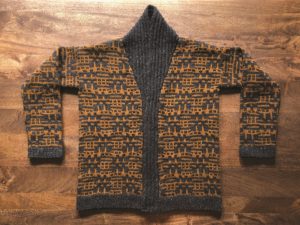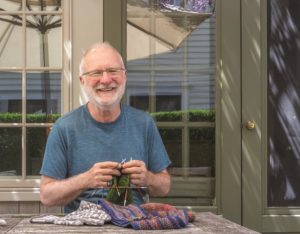Diane Midura is still flying her knitted Ukrainian flag outside Ocean Purls, her Eastham yarn shop. “I started knitting it days after the Russian invasion,” she says. She didn’t think she’d need to fly it for this long.
It’s a surprising and original rendition of a flag, reimagining something mass-produced with a simple knit stitch in durable yellow and blue yarn. It hangs heavier than most flags but still sways gently in the wind. She recently made a similar flag with pride colors that also flies outside her shop.
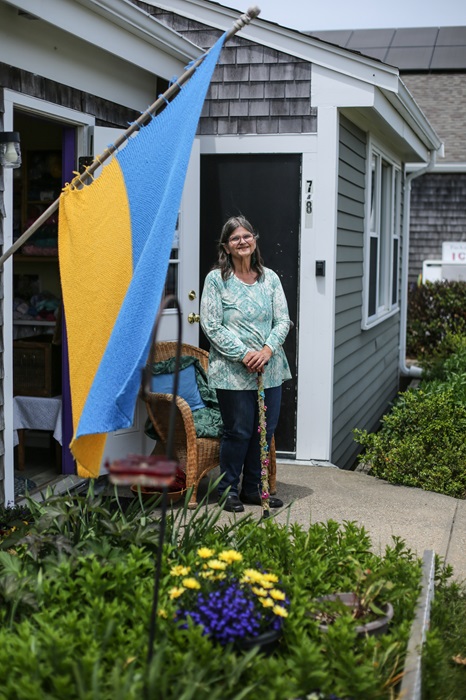
“For me, knitting is an act of love,” says Midura. “When you make something with your own hands, that says something. You can use that to try to heal the world.”
The Ukrainian flag is Midura’s statement, she says, that “Ukraine needs to remain free, be its own country, and have its children returned.” It’s one heartfelt gesture among many that Midura makes with her yarn and needles.
A more personal gesture covers her cane. “I was very angry that I had to use it,” says Midura, who is recovering from knee surgery. A friend suggested that she knit her cane a sweater as a way to make friends with it. Now, small knitted flowers and a green vine encircle its loosely stitched beige covering.
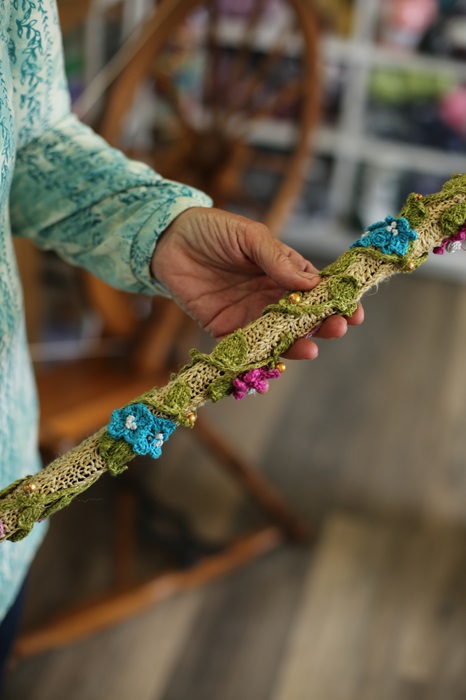
Peace might be elusive on the global stage, but for the time being, Midura has made peace with her cane.
She has been knitting since she was a child. “My mother put knitting needles in my hands when I was four years old,” she says. “My father could always make things, fix things, and he would do it with us.” Gifts were always handmade in her family.
Midura moved from her hometown of Windsor, Conn. to Boston to study flute at Berklee College of Music. Later, she got an M.B.A. from Boston College and worked in accounting at Management Sciences for Health, a nonprofit that sent her to South America and Africa as a contractor for USAID. In 2020, she opened Ocean Purls as “a retirement gig” in the spot where the Yarn Basket had been, next to Ace Hardware.
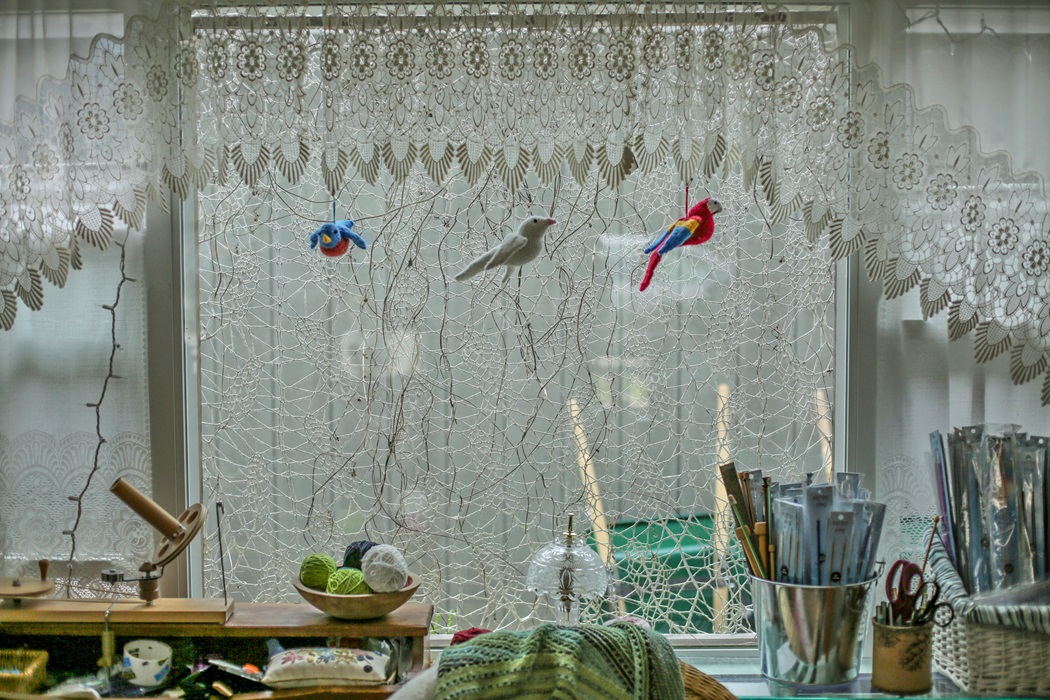
For Midura, knitting, accounting, and music are connected. “It’s all logical, linear thinking,” she says. She likes to get in at least a half hour of knitting in the morning — even in the summer. She makes trellises for her garden and summer wraps from lightweight linen yarn.
“In August, you still need a shawl around your shoulders,” she says, pointing out a purple shawl she knitted in an intricate lace pattern. One of her trellises, knitted in the same durable yarn with which she makes flags, covers the outside of the picture window at the rear of her shop. She knitted it in a loose spider-web pattern four years ago, and it has withstood the elements since, acting as a support for plants growing in flower boxes.
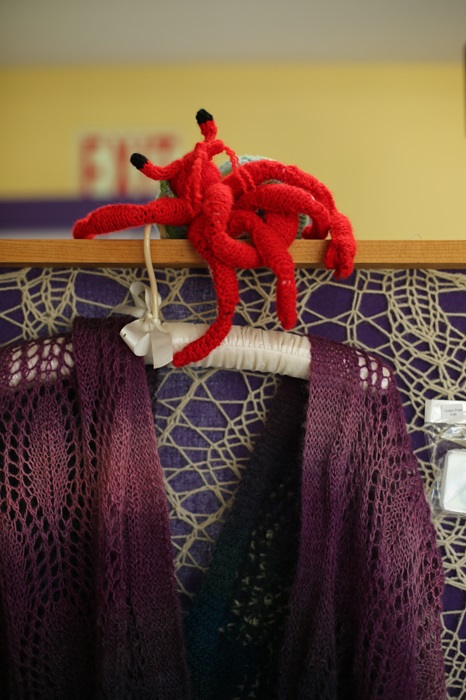
“Knitting is a slow art — things take time,” says Midura. It’s not always easy for her hands to keep up with her mind, which is racing with ideas. Sometimes, she’ll start knitting without a plan. In the corner of her shop is an impromptu piece that turned into a slipcover for a chair. “Like a lot of knitters, I have a hard time sticking to one project,” she says.
Midura has created knitted nests for orphaned birds that are used at Wild Care in Eastham. The nest can be rolled up and closed at the top for wrens, which like to be hidden, or it can be rolled down to form a bowl-like shape preferred by robins. Midura, a self-described “bird nerd,” volunteered at Wild Care until recently and has taken care of abandoned parrots for the past 30 years. Two are living at her house.
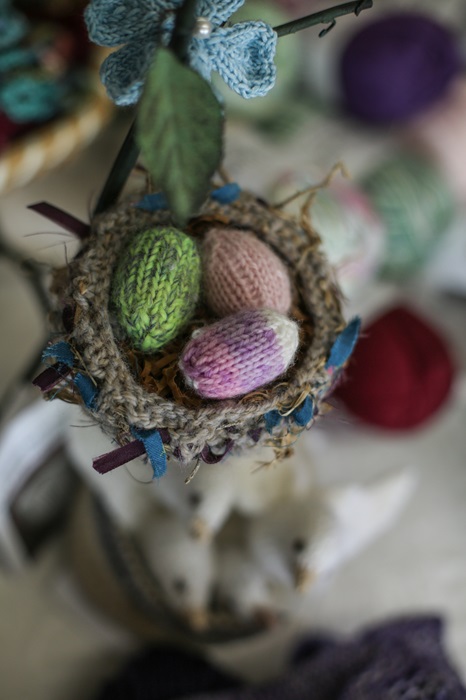
In May, Midura had a sign on her window that read “$4 4 Human Rights.” It was advertising her initiative to donate $4 to the ACLU for every skein of yarn she sold. “I felt a little nervous about making a political statement, but I had to do something,” says Midura. “I see what’s happening to this country. I see people being snatched off the street, the Constitution being trampled on, and lawlessness. I see Germany in the 1930s right here.” She chose the ACLU, she says, because “they are fighting to uphold the Constitution and for civil liberties.”
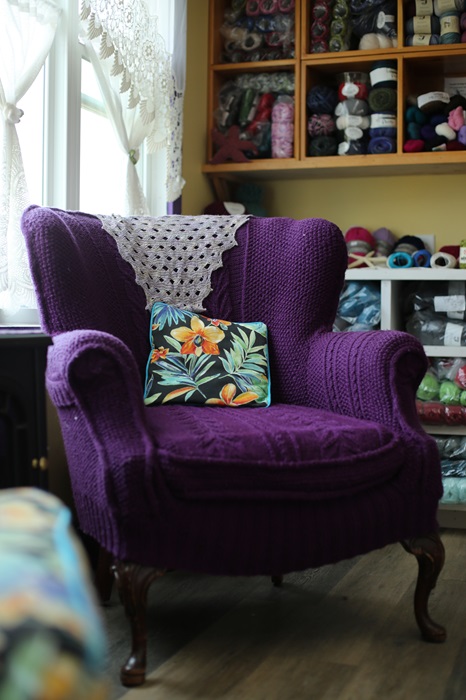
She continues quietly: “Never in a million years did I think this would be happening in the United States. It’s ironic. I’m researching how to get a Polish passport. My family came from Poland for the freedoms that we are losing now.”
This isn’t the first time Midura has used her knitting for a cause. When several Afghan families were resettled on the Cape, Midura donated yarn and helped coordinate a group of women to knit blankets, shawls, mittens, and sweaters.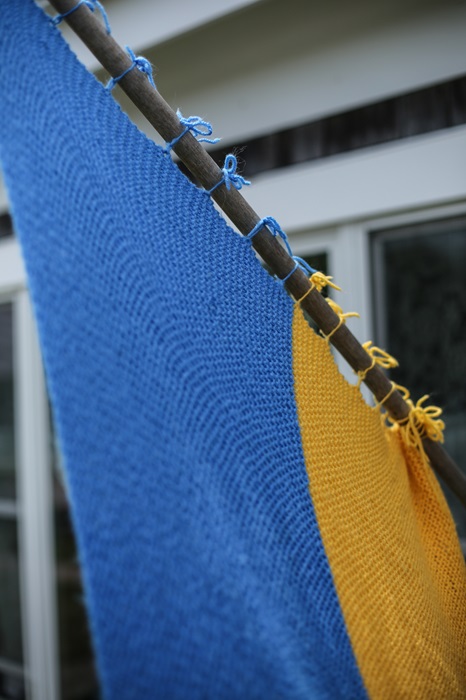
“When you have a crisis, you knit something,” says Midura. “That heals people.”
On the Fourth of July, Midura will have her shop open. She has an umbrella and chairs set up outside. “We will be sitting and knitting and reading the Constitution,” she says. Every customer who buys yarn on the holiday will receive a free copy of the Constitution, while supplies last.
